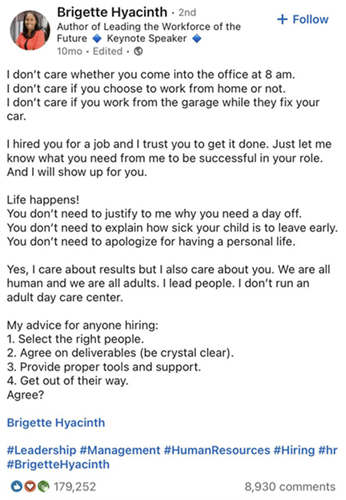Articles and insights
- Content hub
The latest reports, editorial and thought leadership from our experts.
More to explore
- Sustainable marketing
- Media Advisory Panel

Leading teams in 2023: A Journey towards high performance
By Jack Lowman, CIM Course Director and founder of Hack Yourself
As economic conditions around the world continue to prove challenging, 2023 is sure to bring renewed attention to the hybrid working debate. We will likely see more headlines about successes and failures of flexible working patterns, varying employee output, the return (or not) to the office, and a host of new approaches taken by leading businesses to ensure that productivity remains high.
Sir James Dyson is the latest in a string of high-profile figures to contribute to the discourse around home working, going so far as to describe the trend as ‘staggeringly self-defeating’ in a piece for The Times in December 2022. Dyson’s comments follow the UK Government’s recent decision to allow British workers to request flexible working patterns as soon as they start a new job. Previously, this was limited to employees who had been at a company for a minimum of 26 weeks.
Despite the outcry from industry leaders such as Dyson, flexible working remains a key priority for many UK workers. According to a recent survey of 500 UK HR professionals conducted by IWG, “almost two thirds (64 percent) have experienced applicants turn down a job because of a lack of wellness benefits such as flexible working.” As a result, “around two-thirds [of UK HR professionals] (62 percent) said they have introduced a hybrid working policy post-2020 following the pandemic and are seeing positive results”.
There are a number of different approaches being trailed by industry leading businesses, some of which have proven more successful than others. For example, General Motors (GM) who employ roughly 94,500 people have had to step back on its return-to-office policy after a colleague backlash. Parent company of Snapchat, Snap Inc’s CEO has asked employees to be present 80% of the time whilst banking giant Morgan Stanley has asked for five days per week. However, Twitter’s new owner, Elon Musk, has trumped this by scrapping its working from home policy and insisting each employee is present for at least 40 hours a week as a minimum.
Whether your organisation is requesting 5 days per week, 3 days per week or offering total flexibility, it is clear that this is a deal breaker for many employees. Almost half of UK office workers (47%) said they would walk away from their current job if flexibility was not provided by their employer (May 2022).
More recent data from Raconteur found that hybrid and flexible working has overtaken salary as the number one factor influencing members of Gen Y and Z when choosing where to work.
DP Research Institute’s annual survey of 32,000 workers across 17 countries provides further insight into the global workforce’s stance on flexible working, with a study finding that that 64% of respondents would consider quitting if their employer asked them to come back to the office full time.
Establishing an equilibrium that serves both employers and employees equally will be a difficult balancing act. In fact, a disconnect of epic proportions is clear when you dig into what’s called ‘productivity paranoia’, a term that’s arisen from recent research by Microsoft’s Work Trend Index that showed only 12% of leaders say they have full confidence their team is productive. On the flip side, 87% of employees say the complete opposite; that they are productive. We are, as they say, on completely different pages.
In uncertain times, you must deal with what’s in front of you.
And what’s in front of us is millions of people working differently – whether that’s at home, in the office, remotely, in shared workspaces or in a hybrid fashion. And that’s on top of part-time hours, job sharing, compressed hours, flexitime, or phased retirement.
Microsoft’s Work Trend Index further suggests that “Closing the feedback loop is key to retaining talent. Employees who feel their companies use employee feedback to drive change are more satisfied (90% vs. 69%) and engaged (89% vs. 73%) compared to those who believe their companies don’t drive change.” Highlighting that, as leaders, we must invest energy to ensure we listen to our employees and keep them happy and healthy, in order to see the impact we need.
Take a quick read of this popular post on LinkedIn from a nearly a year ago:

With nearly 180,000 likes and 9,000 comments, this post about trusting your employees went down a storm. And it hit the right tone for that moment in time – but I’d argue we must move on to the next chapter, because in the midst of these noble leadership endeavours, what becomes of the employee who is simply trusted to get on with it?
As leaders, – are we doing enough to properly support our team members?
Over the last year I’ve trained upwards of 1,000 emerging leaders and not one, repeat not one, has had dedicated training to upskill them on solo working or how to self-lead in a flexible environment.
In the rapid transition to independent, resilient, solo-working, there will naturally be a skills gap – it will take time for people to develop the skillsets required to properly lead themselves and understand how to achieve high levels of personal performance in a changing world.
Personally, I’m worried that many business leaders will end up looking back in 10 years’ time at a failed experiment which left millions without the skills and mindset to adapt and flourish under their newly found freedoms and autonomy.
If the leadership of today is about trusting and empowering our staff to work flexibly, then it must come with the added responsibility of making sure they are properly supported to be the best that they can be.
Boost your team’s performance with these top tips:
My sense from training employees at all levels, across multiple sectors is that employees are reluctant to talk about a lack of effectiveness in a flexible working role, for fear that these freedoms could be restricted. People don’t ask for help and they don’t challenge themselves to develop as professionals. Silence, in this respect, is the enemy of high performance.
Leaders: it’s down to you to be proactive in upskilling your teams in 2023, because the world of work has changed, and so must we.
If you want to ensure your team is primed for high performance, why not find out more about CIM course director, Jack Lowman’s ‘Hack Yourself – Personal Performance for Marketers’ course. This course helps leaders provide their team members with the skills required for self-leadership, communication and collaboration. You can also get in touch here to explore us running this in-house, for your whole team.

An overview of CIM our history and services.
We’ll always treat your personal details with the utmost care and will never share or sell them to third parties. You are always in control of how we contact you – you can change your contact preferences at any time. For more information, visit our privacy policy.
To receive sector specific news: